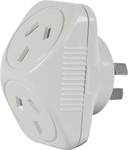Hey folks this seems cheap only $1 for this Arlec double adapter usually it is $1.65.
Plug 4 into each other to get a 5 socket power board :P
Last time i payed about $3.50 for a double adapter i didn't see this one at Bunnings i went fancy bought a HPM.


Excellent price! I'll look out for these.